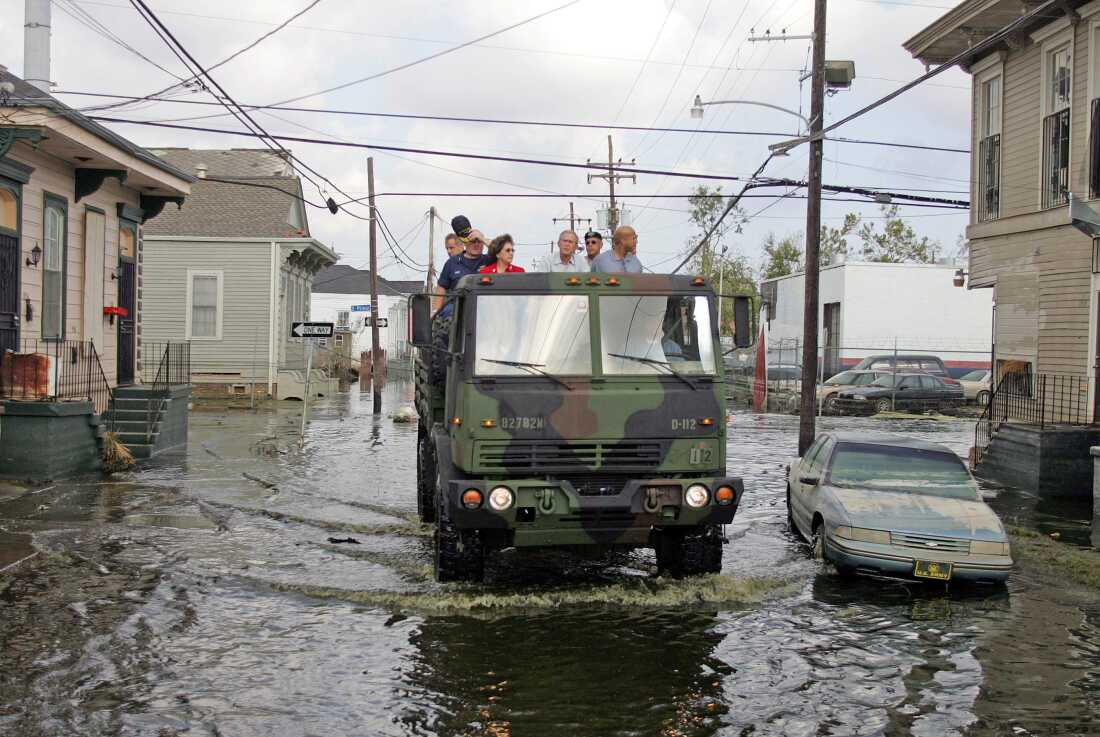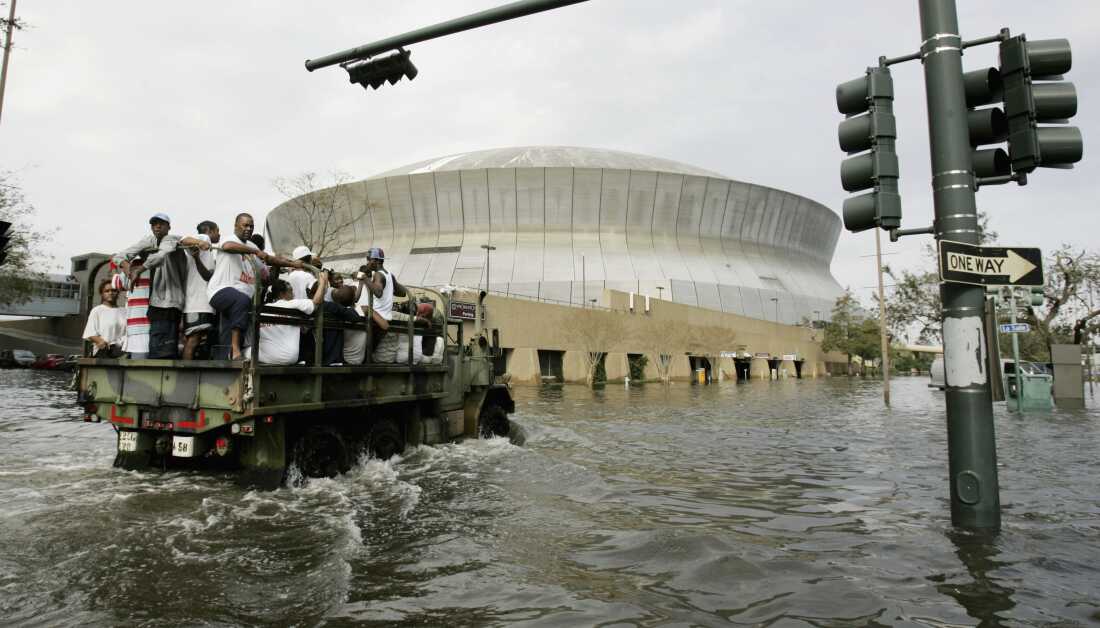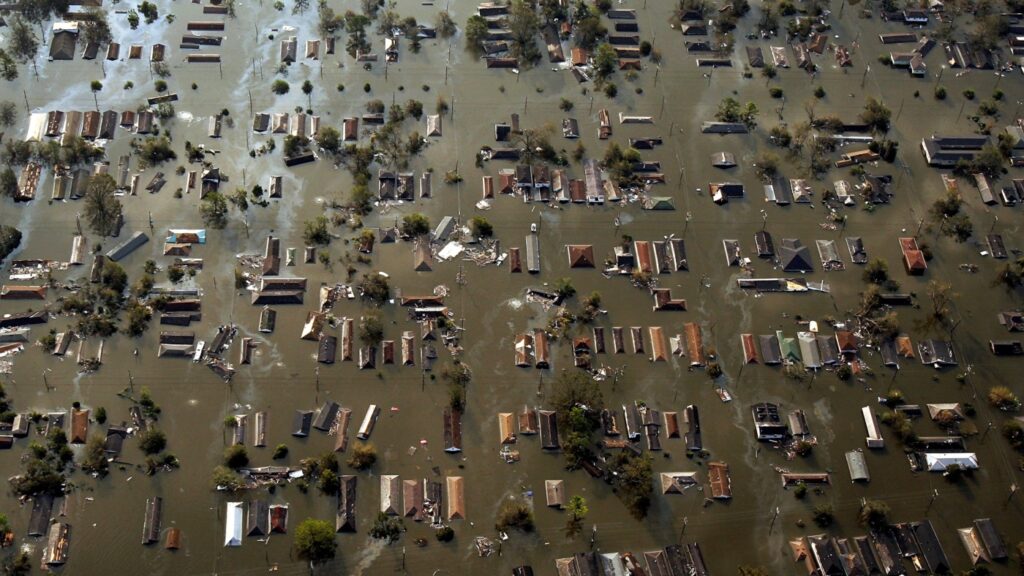Water surrounds homes in the devastated 9th Ward in this aerial view of damage from Hurricane Katrina in New Orleans on Aug. 30, 2005.
Smiley N. Pool/Houston Chronicle via Getty Images
hide caption
toggle caption
Smiley N. Pool/Houston Chronicle via Getty Images
New Orleans and the Gulf Coast region are marking the 20 year anniversary of Hurricane Katrina, which occurred on Aug. 29, 2005.
The historic predominantly Black community of the Lower 9th Ward held thousands of families and had a high rate of multi-generational homeownership.
Multiple levee breaches inundated the entire Lower 9th Ward during the storm, killing many and damaging or destroying thousands of homes.
Katrina resulted in nearly 1,400 deaths, according to revised statistics from the National Hurricane Center, and remains the costliest storm in U.S. history at around $200 billion in today’s dollars.
Here is what it looked like.

Mark Benton (R), of Louisiana Department of Wildlife and Fisheries, helps to rescue young family members after they were trapped on a school rooftop with dozens of others in high water after Hurricane Katrina on Aug. 30, 2005 in New Orleans. Katrina made landfall as a Category 4 storm with sustained winds in excess of 135 mph.
Mario Tama/Getty Images
hide caption
toggle caption
Mario Tama/Getty Images

Residents are rescued by helicopter from the floodwaters of Hurricane Katrina on Sept. 1, 2005 in New Orleans.
David J. Phillip/AP
hide caption
toggle caption
David J. Phillip/AP

President George W. Bush (Center), New Orleans Mayor Ray Nagin (Right), Louisiana Gov. Kathleen Blanco (2nd Left) and Vice Admiral Thad Allen (Left) tour through an area of New Orleans, where the flood waters recently receded on Sept. 12, 2005. Entire neighborhoods were still stewing in a quagmire of mud and foul floodwater that in some cases almost reach up to rooftops. Some suburbs had been obliterated and the death toll, though lower than feared, still climbed steadily.
Jim Watson/AFP via Getty Images
hide caption
toggle caption
Jim Watson/AFP via Getty Images

Kathy Smith, who chose not to evacuate the area because she learned she couldn’t bring her cats along, stands in front of her home in the flooded 9th Ward neighborhood of New Orleans. As the city evacuated, already traumatized victims of Hurricane Katrina made a choice: Head for safety or stay behind with a beloved pet.
Corey Sipkin/New York Daily News via Getty Images
hide caption
toggle caption
Corey Sipkin/New York Daily News via Getty Images

Water spills over a levee along the Inner Harbor Navigation Canal in the aftermath of Hurricane Katrina on Aug. 30, 2005 in New Orleans. It is estimated that 80% of New Orleans is under flood waters as levees begin to break and leak around Lake Pontchartrain.
Vincent Laforet/Pool/AFP via Getty Images
hide caption
toggle caption
Vincent Laforet/Pool/AFP via Getty Images

Floodwaters from Hurricane Katrina fill the streets near downtown New Orleans, on Aug. 30, 2005.
David J. Phillip/AP
hide caption
toggle caption
David J. Phillip/AP

In this Aug. 30, 2005 file photo, rescue personnel search from victims as they traverse the New Orleans 8th Ward in the flooded city of New Orleans.
Dave Martin/AP
hide caption
toggle caption
Dave Martin/AP

Mark Benton, of Louisiana Department of Wildlife and Fisheries, helps to rescue 3 month old Ishmael Sullivan from a school rooftop after he and his mother were trapped with dozens of others in high water after Hurricane Katrina Aug. 30, 2005 in New Orleans.
Mario Tama/Getty Images
hide caption
toggle caption
Mario Tama/Getty Images

National Guard trucks haul residents through floodwaters to the Superdome after Hurricane Katrina hit in New Orleans on Aug. 30, 2005.
Eric Gay/AP
hide caption
toggle caption
Eric Gay/AP

Quintella Williams feeds her 9-day-old baby girl, Akea, outside the Superdome in New Orleans, on Sept. 1, 2005 as she awaits evacuation from the flooded city. Shots were fired and a near riot erupted at the arena as thousands of displaced refugees who had taken shelter there after Hurricane Katrina fought to board the buses for the Astrodome in Houston.
Michael Appleton/NY Daily News Archive via Getty Images
hide caption
toggle caption
Michael Appleton/NY Daily News Archive via Getty Images

Victims of Hurricane Katrina are shown outside the Louisiana Superdome as they wait for evacuation, on Sept. 1, 2005, in New Orleans.
Phil Coale/AP
hide caption
toggle caption
Phil Coale/AP

Terri Jones tries to cool fellow Hurricane Katrina flood victim Dorthy Divic, 89, who was overheated and exhausted at the Convention Center on Sept. 1, 2005 in New Orleans.
Eric Gay/AP
hide caption
toggle caption
Eric Gay/AP

In this U.S. Coast Guard handout, U.S. Coast Guard Petty Officer Scott D. Rady of Tampa, Fla., gives the signal to hoist a pregnant woman from her apartment in the aftermath of Hurricane Katrina on Aug. 30, 2005 in New Orleans. According to the Coast Guard, they rescued 11 survivors from the apartment building.
U.S. Coast Guard/Getty Images
hide caption
toggle caption
U.S. Coast Guard/Getty Images

President George W. Bush looks out over devastation from Hurricane Katrina as he heads back to Washington D.C. Aug. 31, 2005 aboard Air Force One.
Paul Morse/White House via Getty Images
hide caption
toggle caption
Paul Morse/White House via Getty Images

A military helicopter drops a sandbag as work continues to repair the 17th Street canal levee in New Orleans, in the aftermath of Hurricane Katrina, on Sept. 5, 2005. After Hurricane Katrina’s monster storm surge roared ashore, Corps-constructed levees and floodwalls failed near Lake Pontchartrain and along the Lower 9th Ward, inundating most of the city.
David J. Phillip/AP
hide caption
toggle caption
David J. Phillip/AP


